Scotch Macaskill's Wildlife Blog
IMPORTANT: Please note that from April 2009 this Blog's Web address changed as a result of a switch in the blogging platform we use. It's still an integral part of the Wildlife Pictures Online website and, we hope, will continue providing entertaining and enjoyable content in the form of wildlife images, news, views and information.
For the most recent posts, links, and other resources, please visit the new Wldlife Photography Blog.
|
New Photo of the Day Contest
January 3, 2007
|
|
Earth Shots (www.earthshots.org) is a recently launched blog that features a Photo of the Day "celebrating the beauty and diversity of our planet".
Founder Will Lucas has put a great deal of effort into the site to ensure the quality of the images submitted is as high as possible. In this he has succeeded admirably,
as every winning "Photo of the Day" that I've seen has been outstanding. There is also a striking variety of images, ensuring that each day provides a fresh and tantalizing visual feast.
For photographers, the site is a superb way to showcase outstanding work. Any subject that illustrates Earth's beauty and diversity is acceptable, provided that images are interesting and striking.
Definitely worth subscribing, whether or not you're a photographer.
|
Today's Picture: Leopard Mother and Sub-Adult Cub
January 3, 2007
|
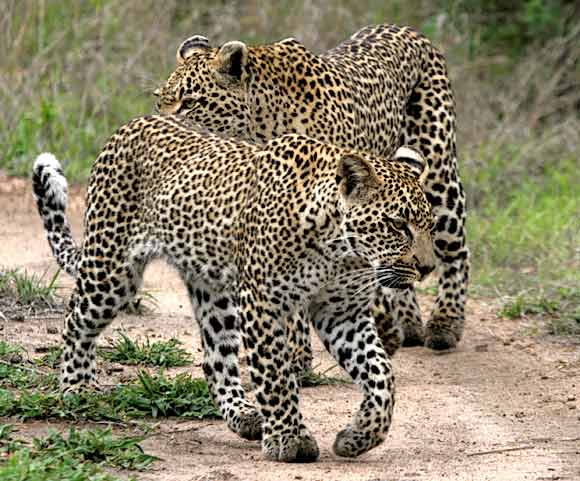
Photo Details: A leopard mother (Panthera pardus) with her sub-adult cub of about 18 months
(front), on an early morning reconnaissance, Elephant Plains Game Reserve, Sabi Sands, South Africa.
Camera: Canon EOS 400D; Lens: Canon 100-400 IS Zoom; Focal Length: 275mm; Shutter speed: 1/400;
Aperture: f/5.6; ISO: 400.
|
Today's Picture: Impala Ram with Redbilled Oxpecker
January 5, 2007
|
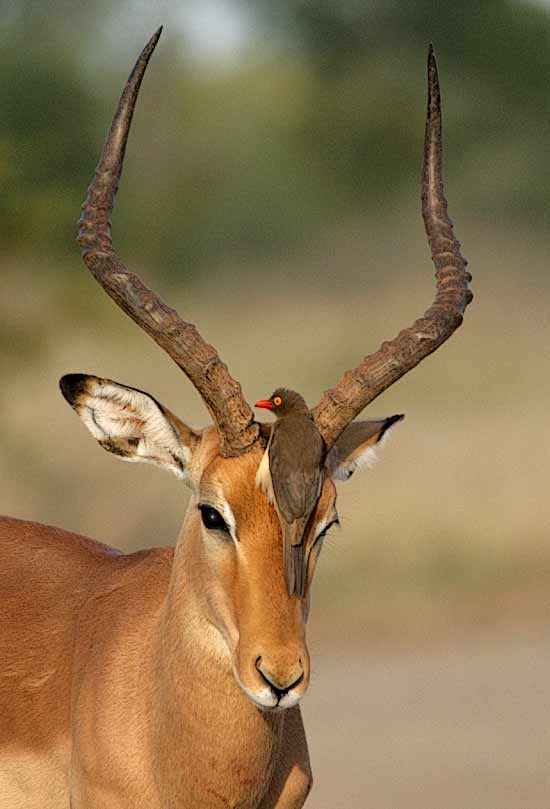
Photo Details: This fine specimen of an adult impala ram (Aepyceros melampus) appears quite unfussed about the redbilled oxpecker (Buphagus erythrorhynchus) perched on its forehead, Kruger National Park, South Africa.
Camera: Canon EOS 400D; Lens: Canon 100-400 IS Zoom; Focal Length: 400mm; Shutter speed: 1/800; Aperture: f5.6; ISO: 400.
Additional Info: Oxpeckers can often be seen clinging to the heads and torsos of wild animals like antelope, giraffe, rhino, and buffalo (and also domestic cattle). They're there to remove ticks, flies, and maggots from the animals' hides. While this removal of parasites would appear to benefit the animal, the oxpeckers' constant pecking also causes small wounds that in turn attract more parasites - and hence more aggravation for the animal. Seems like the oxpecker is the only winner here.
For a different photo of a young impala with oxpecker, see my blog post of
April 10, 2006.
|
Today's Picture: Giraffe Browsing
January 7, 2007
|
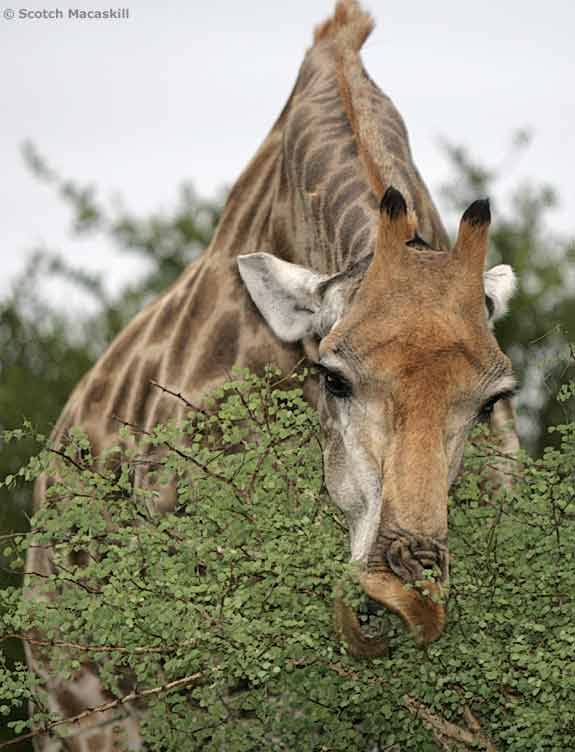
Photo Details: Giraffe (Giraffa camelopardalis) selectively browsing green leaves from top of thorn tree, Kruger National Park, South Africa.
Camera: Canon EOS 400D; Lens: Canon 80 -200 F2.8 Zoom; Focal Length: 200mm; Shutter speed: 1/125; Aperture: f2.8; ISO: 400.
|
Today's Picture: Baby Vervet Monkey
January 10, 2007
|
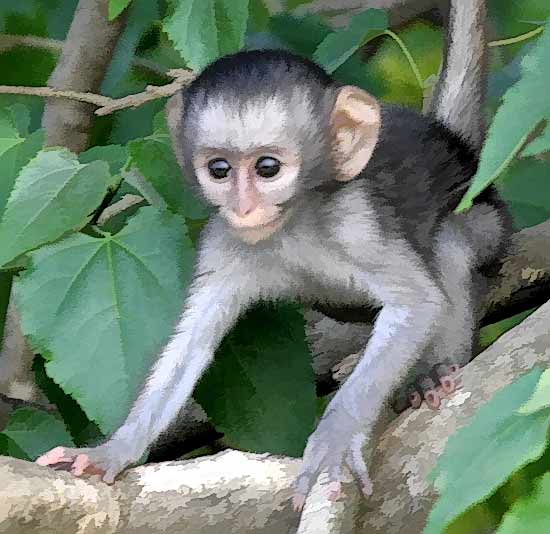
Photo Details: Baby Vervet Monkey (Cercopithecus aethiops) emerges briefly
from the safety of a leafy tree to see what the rest of the world is doing, Kruger National Park, South
Africa.
Camera: Canon EOS 400D; Lens: Canon 100-400 IS Zoom; Focal Length: 400mm;
Shutter speed: 1/125; Aperture: f5.6; ISO: 400.
Additional Info: Yes, of course the picture has been digitally manipulated! This baby
monkey was far away when I snapped it, so the subject only fills a small portion of the frame. I was
also hand-holding a 400mm lens from inside a vehicle, so for me the cropped image is simply not
sharp enough to stand on its own as a wildlife photograph.
But I like the overall picture. Solution: give it a digital "brush" so it has a softer, painterly look.
Many people wouldn't agree with this approach, but I don't have a problem using digital means to
change or improve an image, provided you don't claim it's anything else. What do you think? Feel free to add your comment below.
|
Today's Picture: Saddlebilled Stork
January 14, 2007
|
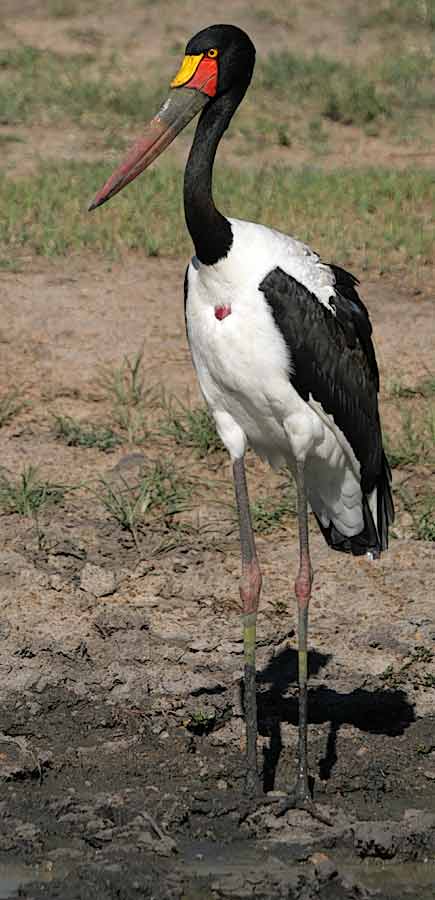
Photo Details: Saddlebilled Stork (Ephippiorhynchus senegalensis) standing on the edge of a muddy waterhole, Elephant Plains Game Reserve, Sabi Sands, South Africa.
Camera: Canon EOS 400D; Lens: Canon 100-400 IS Zoom; Focal Length: 250mm;; Shutter speed: 1/1250; Aperture: f5; ISO: 200.
Additional Info: The photo above is of a female saddlebilled stork, indicated by the bright yellow iris and black pupil of the eyes. The male saddlebill has a rather less colorful brown iris.
These large, striking birds are unmistakable because of the prominent red and black bill topped at the base with a bright yellow "saddle". The legs are black, while the feet and knee joint are red. In the photo above, the bird's bill and legs are coated in mud as a result of its hunting for fish in the shallows, tending to dull the usually strong colors. The crimson spot on the breast is a naked patch, also a characteristic of the saddlebill.
|
Today's Picture: Hippo Spraying Water
January 16, 2007
|
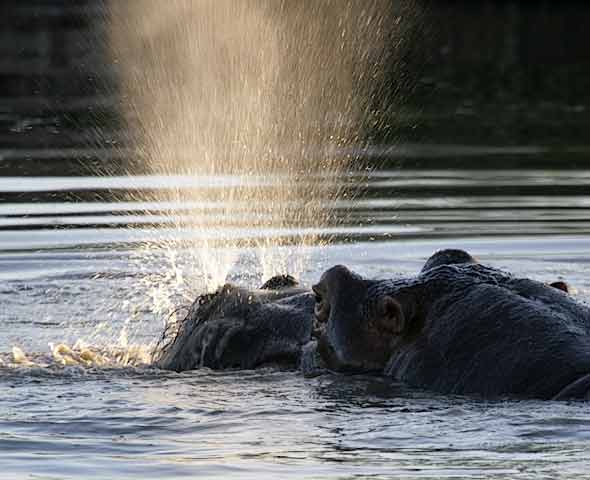
Photo Details: Hippopotamus (Hippopotamus amphibius) sprays a curtain of water as it exhales explosively, Elephant Plains Game Reserve, Sabi Sands, South Africa.
Camera: Canon EOS 400D; Lens: Canon 100-400 IS Zoom; Focal Length: 400mm;; Shutter speed: 1/160; Aperture: f5.6; ISO: 200.
Additional Info: Mature hippos can stay under water for up to five minutes, but generally come up for air after shorter intervals. They even rise for air in their sleep, the act of surfacing being quite involuntary.
When a hippo dives, its nostrils close, only to open again as it resurfaces, letting out a blast of pent-up air. This exhalation can be quite explosive, as in the photo above, and forms part of a hippo's dominance or threat displays. Other examples of dominance/threat behavior include yawning, water-scooping, and head-shaking.
Hippos are reputed to kill more people than any other of Africa's wild mammals, but this is possibly folk-lore and I've never seen any reputable statistics to verify the claim.
|
Today's Picture: Lions Sharpening Claws
January 23, 2007
|
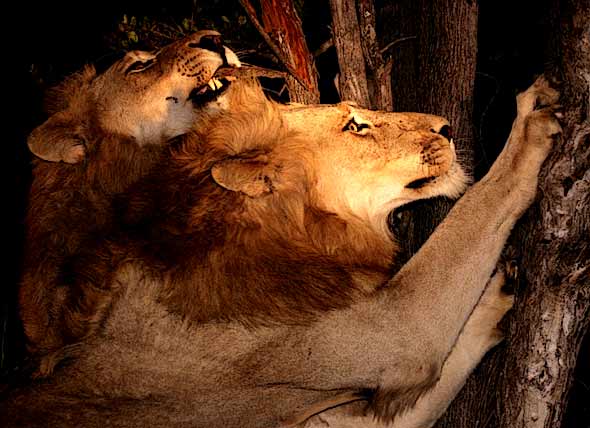
Photo Details: Two male lions (Panthera leo) stop to sharpen their claws on nearby trees, Elephant Plains Game Reserve, Sabi Sands, South Africa.
Camera: Canon EOS 400D; Lens: Canon 100-400 IS Zoom; Focal Length: 120mm; Shutter speed: 1/60; Aperture: f4.5; ISO: 400; Lighting: hand-held spotlight plus on-camera flash with -1 flash exposure compensation.
Additional Info: We were on a night game drive, watching these two male lions by spotlight as they moved silently past our vehicle. Suddenly they stopped in unison at a small clump of trees, reached up with their forelegs and began sharpening their claws on the tree trunks. Then the one (behind) decided to give his teeth some exercise as well by grabbing a strip of bark and ripping it from the tree.
|
Today's Picture: Pansies
January 26, 2007
|
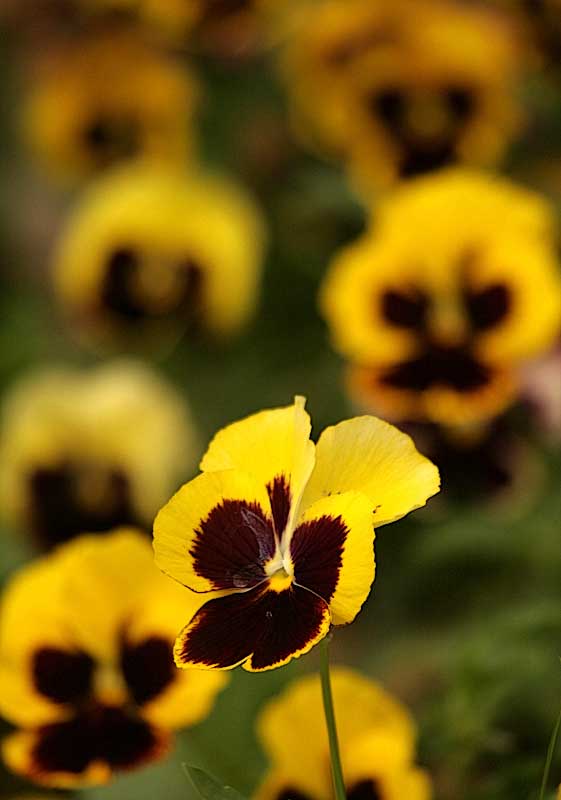
Photo Details: Pansies from a garden in the Midlands of Kwa-Zulu Natal, South Africa.
Camera: Canon EOS 400D; Lens: Canon 100-400 IS Zoom; Focal Length: 400mm; Shutter speed: 1/500; Aperture: f5.6; ISO: 200; Light: soft overcast.
Additional Info: It's the weekend, so I thought a flower picture would be appropriate. I'm not a gardener and know little about flowers, although I enjoy looking them and, when I get the chance, taking pictures of them. The info that follows is courtesy of Wikipedia, the free encyclopedia:
The Pansy or Pansy Violet is a cultivated garden flower. It is derived from the wildflower called the Heartsease or Johnny Jump Up (Viola tricolor), and is sometimes given the subspecies name Viola tricolor hortensis.
Pansies range in colour from gold and orange through to purple, violet, and a blue so deep as to be almost black. They are quite a hardy plant, growing well in sunny or partially sunny positions. Pansies are technically biennials that normally have two-year life cycles. The first year they only produce greenery; they bear flowers and seeds in their second year of growth, and afterwards die like annuals.
The pansy gets its name from the French word pensee meaning "thought". It was so named because the flower resembles a human face and in August it nods forward as if deep in thought.
The word "pansy" has indicated an effeminate male since Elizabethan times.
|
Today's Picture: Muddy Warthog
January 28, 2007
|
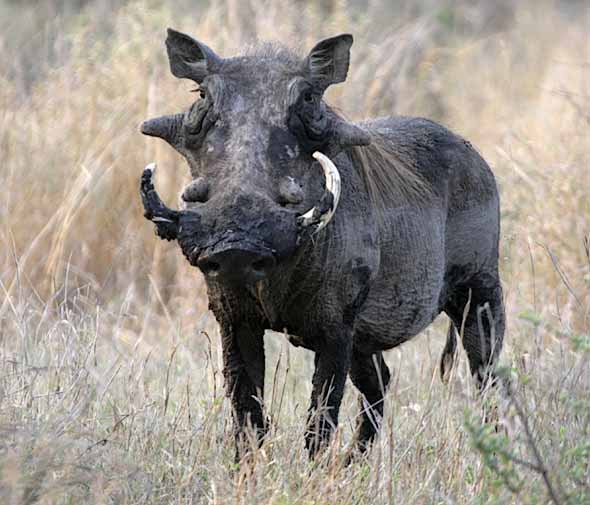
Photo Details: Warthog (Phacochoerus aethiopicus) with prominent facial warts and a fine pair of muddy tusks watches us briefly before turning tail and scuttling off into the long grasss, Kruger National Park, South Africa.
Camera: Canon EOS 400D; Lens: Canon 100-400 IS Zoom; Focal Length: 400mm; Shutter speed:
1/125; Aperture: f5.6; ISO: 400.
|
Today's Picture: Leopard in Tree with its Kill
January 30, 2007
|
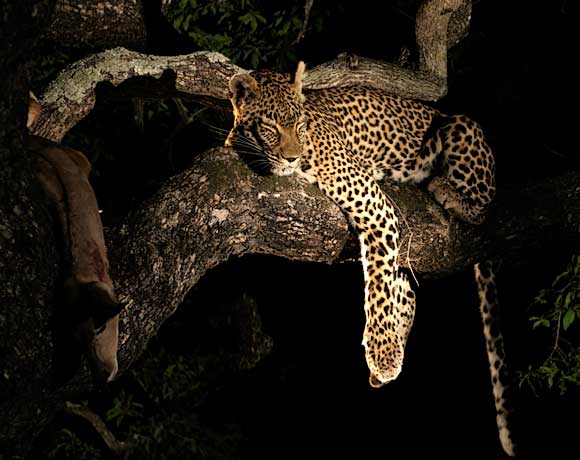
Photo Details: Leopard (Panthera pardus) dozing in tree with its kill, a female kudu, safely
stashed nearby, out of reach of hyenas and other scavengers, Elephant Plains Game Reserve, Sabi Sands, South Africa.
Camera: Canon EOS 400D; Lens: Canon 100-400 IS Zoom; Focal Length: 100mm; Shutter speed: 1/3; Aperture: f4.5; ISO: 400. Lighting from hand-held spots; Exposure Compensation -1
Additional Info: It was after sunset when the tracker on our game drive vehicle, his eyes still glued to the road surface, picked up the spoor of a leopard dragging its kill. He and our driver/guide then casually followed the spoor leading from the sandy road into the bush - on foot and unarmed. They returned shortly to report they'd found a female leopard with her kill fairly close by.
We approached quietly in the vehicle until we could see the leopard lying in the grass with her prey, a young female kudu. The leopard appeared to be resting, probably after the exertion of dragging the large antelope this far. While we watched, two spotted hyena approached, attracted by the smell of blood.
Normally a female leopard, weighing around 40kg (90lbs) is unlikely to take on a single hyena, never mind a pair of them, to protect her kill. Although leopards are incredibly strong for their size, they are more likely to sacrifice a kill than risk an injury that would compromise future hunting.
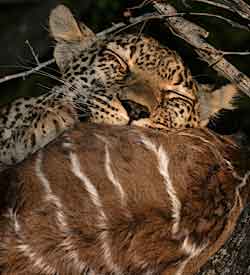 In this case the leopard was simply too quick for the hyenas. In the blink of an eye she had picked up the kudu, covered a dozen yards and bounded up the trunk of a nearby tree. It was awesome, astounding, that she could move so fast while carrying a dead kudu that must have weighed as much as she did. This monumental effort, on top of her previous exertions, had clearly exhausted her and she immediatly fell asleep, her head resting on the kudu's torso (right).
In this case the leopard was simply too quick for the hyenas. In the blink of an eye she had picked up the kudu, covered a dozen yards and bounded up the trunk of a nearby tree. It was awesome, astounding, that she could move so fast while carrying a dead kudu that must have weighed as much as she did. This monumental effort, on top of her previous exertions, had clearly exhausted her and she immediatly fell asleep, her head resting on the kudu's torso (right).
Only after about 10 minutes did she stir, moving to a more comfortable position (as in the main picture above), where she could sleep with her meal securely stashed nearby.
|
| |
| Back to top of page
|
|
Previous Entries
By Month
By Category
My Original Blog
2005 Entries
2004 Entries
2003 Entries
Who Am I?
Brief Bio
|











 In this case the leopard was simply too quick for the hyenas. In the blink of an eye she had picked up the kudu, covered a dozen yards and bounded up the trunk of a nearby tree. It was awesome, astounding, that she could move so fast while carrying a dead kudu that must have weighed as much as she did. This monumental effort, on top of her previous exertions, had clearly exhausted her and she immediatly fell asleep, her head resting on the kudu's torso (right).
In this case the leopard was simply too quick for the hyenas. In the blink of an eye she had picked up the kudu, covered a dozen yards and bounded up the trunk of a nearby tree. It was awesome, astounding, that she could move so fast while carrying a dead kudu that must have weighed as much as she did. This monumental effort, on top of her previous exertions, had clearly exhausted her and she immediatly fell asleep, her head resting on the kudu's torso (right).